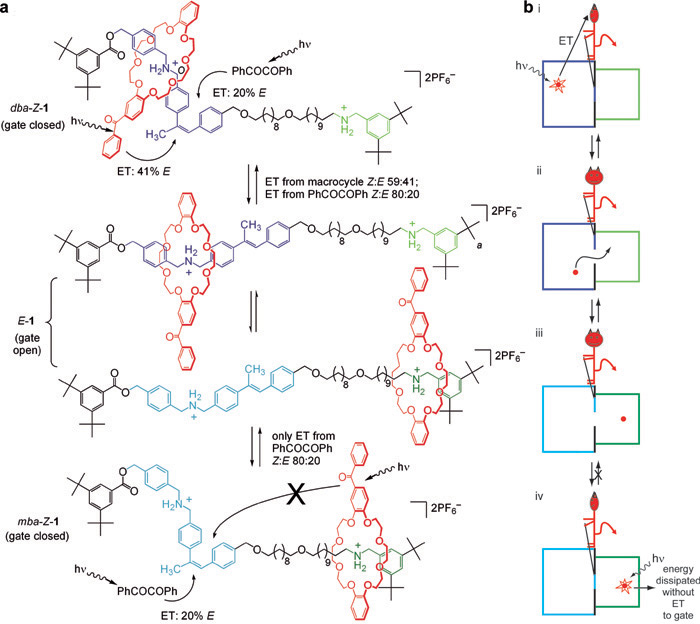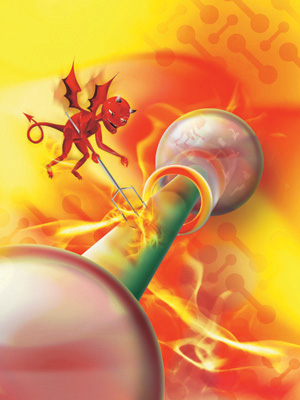Exercising Demons: A Molecular Information Ratchet
‘Exercising Demons: A Molecular Information Ratchet’, Viviana Serreli, Chin-Fa Lee, Euan R. Kay and David A. Leigh, Nature, 445, 523-527 (2007). Full Article. Making the Paper. Nature Nanotech N&V's. How it Works.
Exercising Demons
Now, chemists in the Leigh group have actually made[4] a molecular machine that performs the sorting task envisaged for Maxwell’s pressure demon (Figure 1b) but, crucially, it requires an input of external energy to do so and so does not challenge the Second Law of Thermodynamics. Using light energy, the molecule is able to transmit information about the position of a molecular fragment in a manner that allows transport of the same fragment in a particular direction (Figure 2). This information-based system represents a fundamentally new type of motor-mechanism for synthetic nanomachines.
The new nanomachine belongs to a class of molecules known as ‘rotaxanes’. These structures consist of a molecular ring (‘macrocycle’) trapped on a linear molecular thread by bulky ‘stoppers’ at either end. Molecules of this kind have become popular with synthetic molecular machine designers over the past decade because their architecture restricts significant submolecular motions to only two modes, namely random movement of the ring back and forth along the thread (‘shuttling’) and nondirectional rotation around the thread (‘pirouetting’). But random motion–even cleverly restricted random motion–is not enough to create a molecular machine. An input of energy is required to control how the motion occurs. Various methods for the net transport of macrocycles between different regions in rotaxanes have previously been demonstrated in molecules called ‘stimuli-responsive molecular shuttles’.[7] However, these are simple two-state switches, the most basic and functionally limited type of machine mechanism[8] in which the ring distribution is always at, or relaxing towards, equilibrium. In contrast, biological motors and machines are able to drive chemical systems away from equilibrium,[9] just like Maxwell’s Demon. Only a handful of synthetic molecular machines have been made that can claim to do that.[10-12] Yet, although these structures are relatively diverse (they do not all use rotaxane architectures, for example), they all use similar mechanistic principles in their operation. The latest nanomachine from the Edinburgh group operates using a new and entirely different type of mechanism involving information transfer between the substrate and the machine.

Figure 2. A photo-operated molecular information ratchet. a Irradiation of rotaxane 1 at 350 nm in CD3OD at 298 K interconverts the different forms of 1 and, in the presence of benzil (PhCOCOPh), drives the ring distribution away from its thermodynamic minimum without ever changing the binding strengths of the macrocycle or ammonium binding sites. When the macrocycle is on the mba binding site (green), intramolecular energy transfer (ET) from the macrocycle is inefficient and intermolecular ET from benzil dominates. When the macrocycle is on the dba binding site (blue), both ET mechanisms can operate. The amount of benzil present determines the relative contributions of the two ET pathways and thus the nanomachine’s effectiveness in pumping the macrocycle distribution away from equilibrium. b Cartoon illustration of the operation of 1 as a Maxwellian pressure demon[2c]: i Photo-induced excitation of a particle signals its position in the blue compartment by energy transfer to the demon operating the gate (the demon uses information from the asymmetry in the compartments to distinguish where the excited particles are most likely to be, here through their average distance from the gate). ii & iii The demon opens the gate and the particle shuttles incessantly between the two compartments by Brownian motion until the gate shuts trapping the particle at random in one of them. iv Photo-induced excitation of the particle in the green compartment is ignored by the demon and the energy of the excited state is dissipated as heat.
The new rotaxane molecule has some key novel components in its design. Firstly, the axle is divided into two compartments by a chemical ‘gate’ known as a stilbene. This can exist in two forms: one, the ‘gate-open’ form, allows the macrocycle to pass over it; the other ‘gate-closed’ form blocks motion of the ring. The operating conditions are chosen such that the gate tends to be closed. Each compartment on the axle also contains a ‘binding site’ for the ring – a zone which the ring finds sticky, and so this is where it spends most of its time. In one compartment the sticky region is close to the gate, in the other compartment the binding site is far away from the stilbene. The rings are also special in that an input of light energy gives them the ability to signal their presence to the gate by ‘energy transfer’ (ET, figure 2). This signalling triggers a process that opens of the gate, momentarily allowing the rings to pass, before the gate is returned to its closed state. Because the rings in one compartment spend much more time close to the gate than those in the other, the gate is more likely to be opened by rings moving in one direction than the other. The result is that the number of rings in one compartment increases upon the shining of light on the molecules. We end up with many more rings in this compartment than is statistically expected given its stickiness – the system has been driven away from equilibrium.
Of course, because the information transfer process is powered by the input of light energy this system is certainly not a perpetual motion machine. In fact, modern theoretical physicists had become aware of the possibility of moving Brownian objects by using energy to cause a transfer of information in a mechanism dubbed an ‘information ratchet’. The molecule reported in Nature[4] represents the first time chemists have designed and made such a device in the laboratory.
Nanomachines and nanotechnology
Designing molecular-level systems that employ motion in a useful manner teaches us much about the fundamental mechanical behaviour of matter at small length scales. This in turn helps scientists to unravel how the sophisticated and complicated biomachines of the cell work – crucially important because of the central role they play in many disease states. But the ultimate goal for synthetic molecular machines is to harness their abilities for our own technological use; the creation of artificial nanotechnology. Many believe that a working artificial nanotechnology will ultimately have an impact on our economy and our society that is comparable in scale and scope to the steam engine, electricity, the transistor, and the internet. The realisation of that vision is still some way off, but this new motor-mechanism represents a useful step along the road towards it.[8]
Footnotes and references
[1] (a) B. Mahon, The Man Who Changed Everything: The Life of James Clerk Maxwell, John Wiley & Sons, Chichester, 2004. (b) The year 2006 marked the 175th anniversary of Maxwell’s birth, see www.maxwellyear2006.org.
[2] The first (a) private and (b) public written discussions of the ‘temperature demon’ were: a) J. C. Maxwell, Letter to P. G. Tait, 11 December 1867. Quoted in C. G. Knott, Life and Scientific Work of Peter Guthrie Tait, Cambridge University Press, London, 1911, pp. 213-214; and reproduced in The Scientific Letters and Papers of James Clerk Maxwell Vol. II 1862-1873 (Ed.: P. M. Harman), Cambridge University Press, Cambridge, 1995, pp. 331-332. b) J. C. Maxwell, Theory of Heat, Longmans, Green and Co., London, 1871, Chapter 22. c) Maxwell introduced the idea of a ‘pressure demon’ in a later letter to Tait (believed to date from early 1875). Quoted in C. G. Knott, Life and Scientific Work of Peter Guthrie Tait, Cambridge University Press, London, 1911, pp. 214-215; and reproduced in The Scientific Letters and Papers of James Clerk Maxwell Vol. III 1874-1879 (Ed.: P. M. Harman), Cambridge University Press, Cambridge, 2002, pp. 185-187. “Concerning Demons.... Is the production of an inequality of temperature their only occupation? No, for less intelligent demons can produce a difference in pressure as well as temperature by merely allowing all particles going in one direction while stopping all those going the other way. This reduces the demon to a valve.”. More formally, a pressure demon would operate in a system linked to a constant-temperature reservoir with the sole effect of using energy transferred as heat from that reservoir to do work. This is in conflict with the Kelvin–Planck form of the Second Law whereas the temperature demon challenges the Clausius definition.
[3] For reprints of key papers and commentary on some of the main issues regarding Maxwell’s Demon, see: Maxwell's Demon 2. Entropy, Classical and Quantum Information, Computing (Eds.: H. S. Leff, A. F. Rex), Institute of Physics Publishing, Bristol, 2003.
[4] V. Serreli, C.-F. Lee, E. R. Kay and D. A. Leigh. A molecular information ratchet. Nature, 445, 523-527 (2007).
[5] C. H. Bennett. The thermodynamics of computation – a review. Int. J. Theor. Phys. 21, 905-940 (1982).
[6] R. Landauer. Irreversibility and heat generation in the computing process. IBM J. Res. Dev. 5, 183-191 (1961).
[7] (a) R. A. Bissell, E. Córdova, A. E. Kaifer and J. F. Stoddart. A chemically and electrochemically switchable molecular shuttle. Nature 369, 133-137 (1994). (b) A. M. Brouwer, et al. Photoinduction of fast, reversible translational motion in a hydrogen-bonded molecular shuttle. Science 291, 2124-2128 (2001). (c) Y. Liu, et al. Linear artificial molecular muscles. J. Am. Chem. Soc. 127, 9745-9759 (2005). (d) J. Berná, et al. Macroscopic Transport by Synthetic Molecular Machines. Nature Mater. 4, 704-710 (2005).
[8] (a) E. R. Kay, D. A. Leigh. Lighting Up Nanomachines. Nature 440, 286-287 (2006). (b) E. R. Kay, D. A. Leigh and F. Zerbetto. Synthetic molecular motors and mechanical machines. Angew. Chem. Int. Ed. 46, 72-191 (2007).
[9] M. Schliwa (ed) Molecular Motors (Wiley-VCH, Weinheim, 2003).
[10] (a) D. A. Leigh, J. K. Y. Wong, F. Dehez and F. Zerbetto. Unidirectional rotation in a mechanically interlocked molecular rotor. Nature 424, 174-179 (2003). (b) J. V. Hernández, E. R. Kay, and D. A. Leigh. A reversible synthetic rotary molecular motor. Science 306, 1532-1537 (2004). (c) M. N. Chatterjee, E. R. Kay and D. A. Leigh. Beyond switches: ratcheting a particle energetically uphill with a compartmentalized molecular machine. J. Am. Chem. Soc.128, 4058-4073 (2006).
[11] (a) N. Koumura, R. W. J. Zijlstra, R. A. van Delden, N. Harada and B. L. Feringa. Light-driven monodirectional molecular rotor. Nature 401, 152-155 (1999). (b) S. P. Fletcher, F. Dumur, M. M. Pollard and B. L. Feringa. A reversible, unidirectional molecular rotary motor driven by chemical energy. Science 310, 80-82 (2005).
[12] T. R. Kelly, H. De Silva and R. A. Silva. Unidirectional rotary motion in a molecular system. Nature 401, 150-152 (1999).
‘A demonic rotaxane’. Click on image to download high resolution version (jpeg).
[This illustration by Peter Macdonald – Edmonds UK.]

